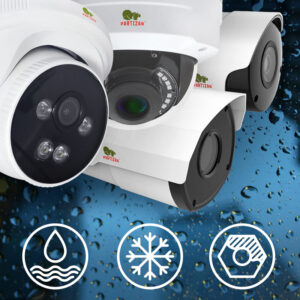 Intruders do not like to deal with objects whose perimeter is guarded by CCTV cameras. Even if uninvited guests get inside the premises, the video recordings will become evidence of the crime. But there are reasons that can negate the effectiveness of outdoor video surveillance. Here, Partizan Security outlines three critical factors for an outdoor video surveillance system
Intruders do not like to deal with objects whose perimeter is guarded by CCTV cameras. Even if uninvited guests get inside the premises, the video recordings will become evidence of the crime. But there are reasons that can negate the effectiveness of outdoor video surveillance. Here, Partizan Security outlines three critical factors for an outdoor video surveillance system
High humidity
A fogged lens is a common problem. There is nothing good in the fact that a CCTV camera shows white haze instead of a clear picture. But condensation is still half the trouble. More importantly, moisture can completely destroy equipment.
Not every CCTV camera can withstand frequent changes in atmospheric pressure and humidity. The body seals may crack from these conditions. Then the water will get inside and spoil everything.
The problem is solved by a competent choice of CCTV cameras. Check with the manufacturer or installer which models are highly moisture resistant.
Some craftsmen practice placing CCTV cameras in an additional waterproof case. But why to do these tricks if it is more logical to buy the right CCTV camera from the beginning?
Bitter frosts
CCTV cameras don’t like extreme cold. Some of them may not even switch on in the bitter frost at all. And ice on the lenses is a nasty thing.
Therefore, please again pay attention to the technical characteristics of the devices. If the manufacturer guarantees that the CCTV cameras remain operational at -40C, this is a good option even for northern countries. And if you put a home device on the facade with a lower temperature threshold of -10C, you risk losing money with the onset of winter. Of course, if you do not live in the tropics.
Something is in the air…
Severe weather conditions are not the only problem that the environment can cause for a video surveillance system. The coastal sea or oceanic zone is always characterised by an increased concentration of salt in the air. Corrosion in such conditions develops very quickly. A similar problem is observed in factories that produce or use strong chemicals.
For these cases, outdoor CCTV cameras should have stainless steel or polycarbonate housing. It will not be superfluous to periodically clean them with fresh water and lubricate the mountings.
Marking will help you!
To understand how suitable the CCTV camera is for outdoor installation, housing protection index IP will help. Probably everyone has seen such markings: IP 66, IP 53, etc.
Its first symbol indicates the level of protection of the device against foreign solid objects:
x – there is no protection data
0 – no protection
1 – protection against the penetration of large objects with a diameter of ≧ 50 mm
2 – protection against objects with a diameter of ≧ 12.5 mm (for example, it can be a finger)
3 – protection against objects with a diameter of ≧ 2.5 mm (cables, nails)
4 – protection against objects with a diameter of ≧ 1 mm (wires, small bolts)
5 – dust protection. A small amount of it can get inside, but will not affect the operation of the equipment.
6 – complete dustproof
The second symbol indicates the level of protection against water:
x – no data available
0 – no protection
1 – protection against vertically falling drops
2 – protection against vertical drops falling at an angle of 15 °
3 – protection against splashes falling at an angle of 60 °
4 – protection against splashes falling in any direction
5 – protection against water jets
6 – protection against a powerful jet of water
6K – protection against a powerful high-pressure jet of water
7 – it is possible to dive up to 30 minutes to a depth of 1 m
8 – it is possible to dive up to 30 minutes to a depth of over 1 m
9 – protection against high-temperature water jet
9K – protection against a powerful high-temperature jet of water
That is, if the documentation contains the IP 66 marking, such CCTV camera can be safely used outdoors. But the IP 53 mark indicates that this is a home gadget. On the street it will feel bad.
So what’s the conclusion?
In any case, installing surveillance CCTV cameras outdoors is a responsible task that requires experience and technical knowledge.
It will not be superfluous to use special sealed glands for Ethernet cables and mounting bases. They will reliably hide the wires, thereby providing the device with additional protection.
And, of course, the equipment itself must meet the assigned tasks!

